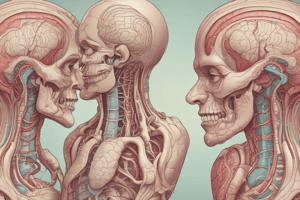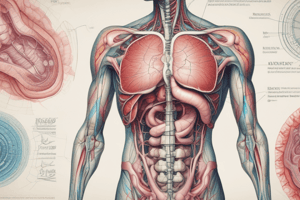Podcast
Questions and Answers
What is the length of the small intestine?
What is the length of the small intestine?
- 6 meters (correct)
- 5 meters
- 7 meters
- 8 meters
What is the process of moving gastric contents to the small intestine?
What is the process of moving gastric contents to the small intestine?
- Absorption
- Digestion
- Not mentioned
- Peristalsis (correct)
What is the approximate length of the small intestine in inches?
What is the approximate length of the small intestine in inches?
- 22 inches
- 15 inches
- 20 inches (correct)
- 18 inches
What is the shape of the small intestine?
What is the shape of the small intestine?
What is the function of the small intestine?
What is the function of the small intestine?
What is the starting point of the large intestine?
What is the starting point of the large intestine?
What is the structure of the cecum?
What is the structure of the cecum?
What is the function of the cecum?
What is the function of the cecum?
What is the purpose of the factors in the intestinal walls?
What is the purpose of the factors in the intestinal walls?
What are Plicae Circulares?
What are Plicae Circulares?
Where does the large intestine extend to?
Where does the large intestine extend to?
What is the function of Plicae Circulares?
What is the function of Plicae Circulares?
What is the name of the valve near the ileum in the small intestine?
What is the name of the valve near the ileum in the small intestine?
What is the layer of the intestine where Plicae Circulares are found?
What is the layer of the intestine where Plicae Circulares are found?
What is the shape of Plicae Circulares?
What is the shape of Plicae Circulares?
What is the function of the tunica muscularis?
What is the function of the tunica muscularis?
What type of muscle is found in the tunica muscularis in the pharynx, mouth and upper esophagus?
What type of muscle is found in the tunica muscularis in the pharynx, mouth and upper esophagus?
What is the relationship between the tunica muscularis and the submucosa?
What is the relationship between the tunica muscularis and the submucosa?
In which part of the digestive system is the tunica muscularis found?
In which part of the digestive system is the tunica muscularis found?
What is the main component of the tunica muscularis?
What is the main component of the tunica muscularis?
What does parasympathetic stimulation lead to?
What does parasympathetic stimulation lead to?
What is the effect of parasympathetic stimulation on the digestive system?
What is the effect of parasympathetic stimulation on the digestive system?
What is the result of parasympathetic stimulation on the digestive system's activity?
What is the result of parasympathetic stimulation on the digestive system's activity?
What is the effect of parasympathetic stimulation on the gut?
What is the effect of parasympathetic stimulation on the gut?
What is the outcome of parasympathetic stimulation on the digestive system?
What is the outcome of parasympathetic stimulation on the digestive system?
Flashcards are hidden until you start studying
Study Notes
Large Intestine
- The large intestine extends from the ileocecal valve to the anus.
- Also known as the colon, it is made up of distinct segments.
Cecum
- The cecum is a saclike structure that makes up the first few inches of the intestine.
- It is the first part of the large intestine.
Small Intestine
- The small intestine is a tube that is approximately 6 meters (20 inches) long.
- It is the longest part of the intestine.
Intestinal Wall
- The intestinal wall is equipped with factors that increase the absorptive surface area.
- These factors include: • Plicae Circulares: circular folds of the intestinal mucosa/mucous membrane lining. • Submucosa: a layer of loose connective tissue that surrounds the mucous membrane. • Tunica muscularis: a layer of muscle that surrounds the submucosa.
Tunica Muscularis
- The tunica muscularis is made up of skeletal muscle in the pharynx, mouth, and upper esophagus.
- It plays a role in the inhibition of the digestive system.
Other Facts
- The enteric nervous system (ENS) is a network of nerve fibers that innervates the digestive system.
- The ENS can function independently of the central nervous system (CNS).
Studying That Suits You
Use AI to generate personalized quizzes and flashcards to suit your learning preferences.



